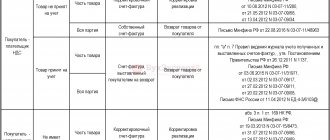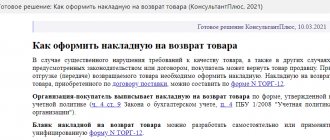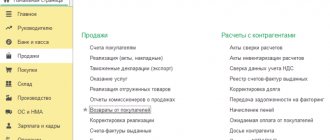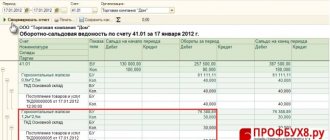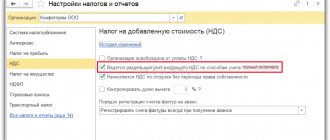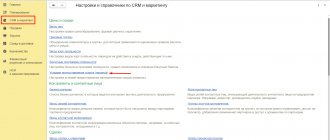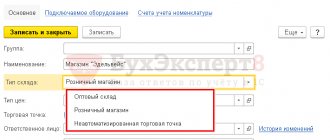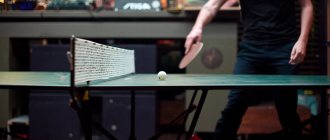Return to supplier - reflected in the VAT return
According to the purchase and sale agreement, the seller's side is obliged to transfer the goods to the buyer into his ownership, and the buyer is obliged to accept it and pay the price - in monetary terms. In case of termination of the contract, the obligations cease.
The parties can agree and establish the return of what was carried out by them before the termination of the agreement. Thus, goods that are of poor quality and accepted for registration by the buyer are subject to return, provided that at the time of acceptance of the goods it was not discovered that their quality does not correspond to the terms of delivery.
If the sale of goods does not take place in the order of returning the goods to the seller, the original purchase and sale agreement is terminated and the original transfer of ownership is cancelled.
Buyer Return Procedure
The buyer may exercise the right to refuse goods that were purchased under a sales contract, as well as the right to demand a refund of the amount paid for the goods, if:
- the seller transferred the goods in quantities less than those specified in the contract;
- a discrepancy between the range of transferred goods and the data in the contract was discovered;
- The product was found with irreparable quality defects in the form of defects or non-compliance with parameters.
- a fact was discovered that the product package did not correspond to that specified in the documents.
Return may be possible by bilateral agreement: after it, the contract is considered terminated (Article 450 of the Civil Code of the Russian Federation). A document confirming termination must be made in the same form as the contract.
Returning goods may be possible before the invoice is certified and after, which means when ownership changes.
Products that do not meet the quality may be returned only with the consent of both parties. In this case, the seller and buyer change places for a while. Returns due to poor quality are subject to invoicing by the former buyer to the supplier for an amount equivalent to the product being returned.
If there was a fact of returning a product of inadequate quality, then in this case it is necessary to draw up a report on the discrepancy or defect, according to which the return process took place.
The procedure for returning goods from a buyer without VAT to a supplier with VAT
If the buyer is recognized as a VAT defaulter, the procedure depends on whether the goods will be returned in whole or in part.
A full refund is issued in the seller's purchase book, namely, the previously issued invoice is registered. This is done on the date when he received the documents from the buyer.
A partial refund must be issued by the seller with a corrective invoice, which in amount must match the amount of the buyer's refund.
However, despite the fact that the goods were returned by a VAT non-payer, the supplier can exercise the right to deduct VAT.
Accounting for VAT on goods return transactions
The return of goods must be reflected in the accounting accounts. Return accounting periods :
- the purchase and return of goods were made in the same reporting period;
- after the end of the implementation year and before the period for submitting the declaration for the current year;
- upon submission of the annual declaration during which the goods were sold.
Accounting entries
The accounting entries are shown in the image below:
Reflection in the declaration
Tax legislation obliges the buyer to reflect invoices issued to the supplier when returning goods previously accepted by him for registration.
If the VAT return is submitted in the same period when the goods were subject to return, and also if the buyer did not accept the goods (ownership remained the same), then the proceeds from such goods, and accordingly the tax base, are reflected on line 010-020 of section 3. The supplier records a deduction for returned goods on line 120 of this section.
Upon the return of low-quality goods, the buyer does not pay VAT, since there is no object of taxation - the sale of goods .
Restoration of VAT for the buyer who returned the goods and issuance of invoices will not indicate a “reverse” sale by the buyer. If it was registered, then you need to carry out a “reverse sale”: present the revenue on line 010, 020 of section 3, and upon returning the goods, you should calculate the VAT deduction based on customer invoices.
Operation codes:
- return of goods by a VAT payer - code 01;
- return of goods by organizations or individual entrepreneurs who do not pay VAT - code 16.
- return of goods by individuals – code 17.
If you return an item that has not yet been accepted for registration (when the seller is recognized as its owner), then such a return is not considered a sale. Therefore, there is no need to charge VAT. No deduction is accepted for input VAT on such goods (based on the fact that they are not registered).
If you are the owner of the product and return it, then it is a sale of the product. In the future, you will accrue VAT payable to the state budget, issue an invoice to the seller, register it in the sales book and display the return in the VAT return as a sale.
You also have the right to deduct input VAT, then you do not have to overpay tax on goods that did not meet your requirements.
Didn't find the answer to your question? Call hotline 8. It's free.
Source: https://zakonguru.com/nalogi-2/nds/declaracia/vozvrat-tovara.html
How is the operation to return purchased goods processed?
When making a sale, the seller pays VAT, and when returning the tax, the tax amounts are deducted.
The Ministry of Finance explains: the buyer, returning the goods that were posted to the warehouse, and preparing a claim, issues a regular invoice to the seller and registers it in the sales book, paying the deductible tax previously accepted when posting the goods, and therefore the purchase.
For the supplier, the invoice will serve as a documentary basis for marking it in the purchase book and accepting previously paid VAT for deduction.
These actions will not entail tax consequences for the buyer, even if the goods were accepted and rejected in different periods. For example, in the first quarter the goods were received, but in the second they were abandoned. In the first quarter, the buyer records the invoice in the purchase book and declares it in the VAT return for the first quarter. it to be deducted. Returning goods in the second quarter. he issues a regular invoice, enters it into the sales ledger and pays the tax. In fact, the buyer returns to the budget the VAT previously accepted for deduction, i.e., issuing an invoice for the return does not place an additional tax burden on him.
Moreover, operations for the receipt and return of goods carried out in the same tax period do not lead to negative consequences. The main condition is the mandatory registration of invoices. Sometimes questions arise: is it necessary to register a “return” invoice issued to the supplier in the sales book, or can the registration mark made when posting the goods be canceled in the purchase book if the return was made for the full cost of the goods.
Since the law establishes absolute registration of all invoices issued, it is imperative that all entries be entered into the books. This is especially important if the item to be returned has been received. The algorithm is usual: when receiving the goods, a registration mark is made in the purchase book, and when registering a return, a registration mark is made in the sales book.
When the buyer submits a VAT return, the amount of tax will be declared for payment, and the VAT on the seller’s account issued upon sale will be deducted.
Unreceived goods
A buyer returning unreceived goods is not required to issue an invoice to the supplier. In this situation, the seller himself sends him an adjustment invoice with corrections based on the received motivated complaint.
The basis for drawing up an invoice are primary documents - a letter of claim and a report on identified defects in goods, usually certified by both parties.
Based on this adjustment, the seller accepts the VAT previously paid upon shipment of the goods as a deduction.
The Ministry of Finance has not yet provided an explanation on how a buyer can register an adjustment account and whether it needs to be done. Common sense dictates that the buyer should note in the purchase book the seller's invoice for only the portion of the goods that will be taken into account. And the buyer’s adjustment invoice issued by the seller is not registered based on the consideration that he did not deduct VAT on the missing goods. All practicing accountants today act this way.
The buyer follows the same analogy if he returns the entire shipment of goods. He does not record either of the two invoices in the purchase book because he did not accept the goods into the warehouse, refusing them upon acceptance.
VAT when returning goods from the buyer
Each buyer has the legal right to return previously purchased goods. In this article we will look at the features of accounting for VAT on transactions when returning goods from a buyer.
Procedure for returning goods from the buyer
The sequence of returning an “unwanted” product, first of all, depends on the reasons for its return. Return of goods from the buyer can be carried out in two cases:
- The purchased product is of good quality.
- The purchased product is not of adequate quality: defective, understaffed, non-compliant with the ordered parameters, etc.
Please note that the return of goods can be carried out both before the bill of lading is signed and after it is signed, that is, when ownership changes.
For example, goods of proper quality can be returned only with the consent of both parties (clause 1 of Article 450 and clause 4 of Article 453 of the Civil Code of the Russian Federation). That is, in this case, the supplier and buyer temporarily change places. Such a return involves an invoice on behalf of the former buyer in favor of the former supplier and only for the amount of the returned goods.
If a low-quality product is returned, then an act of non-conformity or defect is drawn up, according to which the return process itself takes place.
Return of goods from the buyer without VAT to the supplier with VAT
The procedure for returning goods to the seller with VAT from a buyer without VAT, who is on the simplified taxation system, that is, is not a VAT payer, depends on two reasons:
- the product is returned in its entirety;
- The product is partially returned.
Registration of the return of goods is entirely carried out by the seller in the purchase accounting book by registering the invoice he previously issued. Registration is carried out on the date of receipt of documents from the buyer and the goods themselves.
If the goods are returned in parts from a buyer who does not pay VAT, the seller is obliged to issue a corrective invoice. The amount of the adjustment invoice must correspond to the amount of the goods returned from the buyer.
If the goods were released without providing an invoice, that is, by using a cash register system, then the seller is obliged to return the money to the buyer by entering data into the purchase book, namely cash register details. In addition, the seller is obliged to register the receipt of the returned goods.
It is worth considering that even if the goods were returned by a VAT non-payer, the seller does not lose the right to deduct VAT. Thus, for tax accounting the reason for the return does not matter:
Accounting for VAT on transactions when returning goods from the buyer
The procedure for displaying the return of goods on accounting accounts directly depends on the period of receipt of the claim from the buyer:
Get 267 video lessons on 1C for free:
- the sale and return of goods were made within one reporting period;
- at the end of the implementation year, but before the reporting period for that year;
- after submitting annual reports for the year in which the product itself was sold.
Return of goods from the buyer with VAT - postings to the supplier
| Account Dt | Kt account | Transaction amount, rub. | Wiring Description | A document base |
| Receipt of a claim before the end of the current year (cancellation is carried out based on the initial sale) | ||||
| 62 | 90-Sales | 118 000 | Accrued revenue from sales of goods (October) | Invoice and delivery note |
| 62 | 51 | 11 800 | The buyer received a refund for the defective product (October) | Payment order, bank statement, claim from the buyer |
| 90 | 68-VAT | 18 000 | VAT charged (October) | Check |
| 90 | 41 | 100 000 | The cost of goods sold was written off (October) 118,000 – 18,000 = 100,000 rubles. | Accounting information |
| 62 | 90-Sales | 11 800 | Reversal of revenue from defective goods (10 pcs.) (November) RUB 118,000. : 100 pieces. × 10pcs. = 118,00 rub. | Accounting information |
| 90 | 68-VAT | 1 800 | VAT was reversed on defective goods (10 pcs.) (November) 18,000 rub. : 100 pieces. × 10pcs. = 1800 rub. | Accounting information |
| 90 | 41 | 10 000 | The cost of defective goods was reversed (10 pcs.) (November) 100,000 rub. : 100 pieces. × 10pcs. = 10,000 rub. | Accounting information |
| Receipt of a claim at the end of the year of sale, but before filing reports for this period ( reversal is also carried out for the initial sale, but only as of December 31 of the previous year) - the list of transactions is identical to the above example | ||||
| Receiving a claim after approval of annual reports | ||||
| Please note that previous year's accounting records are not adjusted. | ||||
| 62 | 90-Sales | 70 800 | Accrued revenue from sales of goods (December 2016) | Invoice and delivery note |
| 90 | 68-VAT | 10 800 | VAT charged (December 2016) | Check |
| 90 | 41 | 60 000 | The cost of goods sold was written off (December 2016) 70,800 – 10,800 = 60,000 rubles. | Accounting information |
| 91 | 62 | 8 850 | The loss for 2021 is reflected in the amount that must be returned to the buyer (15 pieces) (March 2017) RUB 70,800. : 120pcs. × 15pcs. = 8,850 rub. | Accounting information |
| 41 | 91 | 7 500 | Other income was accrued in the amount of the actual cost of the returned goods (15 pieces) (March 2017) 60,000 rubles. : 120pcs. × 15pcs. = 7,500 rub. | Accounting information |
| 68 | 91 | 1 350 | Acceptance of VAT for deduction (15 pieces) (March 2017) 10,800 rub. : 12 pcs. × 15pcs. = 1,350 rub. | Accounting information |
| Postings upon agreement of the parties (no claim) | ||||
| If the goods are returned under the terms of the supply agreement (for example, there is no demand for the goods) | ||||
| 62 | 90-Sales | 354 000 | Accrued revenue from the sale of goods to the buyer (November) | Invoice and delivery note |
| 90 | 68-VAT | 54 000 | VAT charged (November) | Check |
| 90 | 41 | 300 000 | The cost of goods sold is reflected: 354,000 – 54,000 = 300,000 rubles. | Accounting information |
| 41 | 60 | 24 000 | Returned goods (30 pcs.) (December) 300,000 rub. are displayed at the new cost. : 300pcs. × 0.8 × 30pcs. = 24,000 rub. | Accounting information |
| 19 | 60 | 4 320 | VAT is reflected on the returned goods (30 pcs.) (December) 54,000 rubles. : 300pcs. × 0.8 × 30pcs. = 4,320 rub. | Accounting information |
| 68 | 19 | 4 320 | VAT is deductible on returned goods | Accounting information |
| 60 | 62 | 28 320 | The claims were offset by 24,000 + 4,320 = 28,320 rubles. | Accounting information |
| 51 | 62 | 325 680 | The buyer paid for the unreturned part of the goods 354,000 – 28,320 = 325,680 rubles. | Bank statement |
How to reflect the return of goods from the buyer in the VAT return
The procedure for displaying the return of goods from the buyer in the VAT return directly depends on the reasons for the return.
If the goods were not accepted by the buyer, that is, ownership of the goods was never transferred, then the proceeds from the shipped goods are displayed in the VAT return (line 010 - 020 of section 3 of the VAT return is completed). When returning goods, VAT is deducted on the amount of the returned goods - the basis is the supplier's adjustment invoice.
If the goods were nevertheless registered by the buyer, then it is necessary to carry out a “reverse sale”. Initially, it is necessary to display the proceeds from sales in lines 010 - 020 of section 3 of the VAT return, and upon the fact of returning the goods, it is necessary to display the VAT deduction, but only on the basis of the invoice drawn up by the buyer.
Source: https://BuhSpravka46.ru/nalogi/nds/nds-pri-vozvrate-tovara-ot-pokupatelya.html
Is the buyer subject to VAT when returning goods to the seller: to a VAT defaulter – Legal World
- VAT Adjustment Invoices Accounting for Goods VAT at the rate of 20%
- .
- .
- VAT on Return of Goods
- VAT Advances Offsets Postings
- VAT Typical Errors
- From April 1, 2021, the buyer is not required
- issue invoices for returned goods accepted for registration.
Therefore, from April 2021, when the buyer returns goods that he took into account before and after April 1, 2021.
, the seller issues adjustment invoices.
If the latest VAT on such goods is not available, the seller will not be able to deduct it.
If goods previously purchased and registered by the buyer are subsequently sold on the basis of a purchase and sale agreement (supply agreement), under which the buyer acts as the seller of the goods, and the former seller as the buyer, then invoices are issued for such goods.
If the buyer accepts the goods for registration, but then returns them, the seller must issue an adjustment invoice. These rules are in effect from April 1, 2021.
They apply even if the goods were registered before this date.
Regular invoices are issued if the return is issued as a reverse sale. In this case, a new purchase and sale agreement is required, in which the seller and buyer essentially change places.
- Letter of the Ministry of Finance dated April 10, 2021 N 03-07-09/25208
- VAT Document Forms VAT Online Trading
- .
- .
- .
- Return of goods that were registered before April 1
- When the buyer returns goods accepted for registration before April 1, 2021 and after the specified date, the seller issues adjustment invoices.
- In the absence of an adjustment invoice, the seller cannot deduct VAT on returned goods.
- The exception is cases when goods are sold on the basis of a purchase and sale agreement (supply agreement), under which the buyer acts as the seller of the goods, and the former seller acts as the buyer.
- For such goods the former buyer will issue invoices in the normal manner.
- Accordingly, the former supplier will be able to deduct VAT on returned goods as when purchasing new goods.
- Returning goods under the simplified tax system
- When a defective product is returned to the seller via the simplified tax system, an invoice is not issued.
A seller using the simplified tax system is not a VAT payer and has no right to deduction and does not need an invoice. Since the buyer did not deduct tax when registering the goods, he does not need to issue an invoice when returning the goods.
Previously, the Ministry of Finance considered that low-quality goods that are accepted for registration are returned to the seller - the VAT payer. In this case, the buyer must issue an invoice, otherwise the seller will not be able to deduct the tax.
- The buyer is not required to issue an invoice as the return of a defective item is not a resale.
- Letter of the Ministry of Finance N 03-07-09/64631
- Returning goods in retail
- When returning goods sold in retail trade using cash registers and issuing checks to individuals or other persons who are not VAT payers, that is, without issuing invoices, the seller’s purchase book may record details of cash receipts issued when returning funds to customers , in the presence of documents confirming the acceptance and registration of returned goods.
- In this case, registration of documents in the seller’s purchase book is made on the date of acceptance of the returned goods for registration.
- When returning goods by a buyer who is not a VAT payer, the seller can claim the VAT he paid on the sale of these goods as a deduction, regardless of whether the buyer registered the goods or not.
- This can be done based on the registration of the invoice issued upon shipment in the purchase book in the period in which adjustments were made in connection with the return of the goods.
- If only part of the goods is returned, the seller must issue an adjustment invoice for the cost of the goods accepted from the buyer.
- Letter of the Ministry of Finance N 03-07-09/25208 VAT Advances Offsets Postings
- .
- .
- Resale of goods
- If goods previously purchased and registered by the buyer are subsequently sold at
- on the basis of a purchase and sale agreement (supply agreement), under which the buyer acts as a seller
- goods, and the former seller is the buyer, then invoices in respect of such goods
- are displayed in the usual manner.
- Accordingly, the former buyer in this case issues an invoice to the former supplier.
- This procedure is applicable, but may be difficult to implement (for example, if the original supplier has a license to wholesale the goods, but the buyer does not).
- What should I do when returning an item that was previously shipped?
Source:
VAT upon return from the buyer
In commercial enterprises, it often happens that goods move in the opposite direction - from buyer to seller. The biggest nuisance in such situations is VAT refund. The situation is complicated by the fact that this issue is not clearly defined in the legislation.
Return of goods from the buyer with or without VAT
The Civil Code establishes that a wholesale buyer can return products if:
- the necessary supporting documents were not completed correctly or were not received;
- the volume of goods does not correspond to that specified in the supply contract;
- the assortment does not correspond to that specified in the contract;
- the product is of poor quality;
- products are packaged improperly.
A specific contract may also specify additional conditions under which the buyer has the right to return products to the supplier. In retail, customers return both low-quality and high-quality goods (for various reasons).
Return from the buyer - VAT in retail
In retail, the way returns are accounted for depends on how the item is accounted for: at purchase or sales cost, and when it is returned: on the day of purchase or later. If the buyer returns the purchased products on the day of purchase, then no accounting is required at all - the money is simply returned from the cash register.
If the goods are returned later, the accounting method depends on the accounting policy of the retailer. If goods are accounted for at purchase price, then the sale is reflected:
- D 50, K 90-1 (amount including VAT);
- D 90-2, K41 (cost write-off).
The return is reflected in accounting as follows:
- D 41, K 76 (cost);
- D 76, K50 (full price);
- D 76, K 90-1 (full cost with a minus sign);
- D 90-2, Credit 76 (cost with a minus sign).
If accounting is kept on the basis of the sales price of products, then the following entries must be made upon sale:
- D 50, K 90-1 (total cost);
- D 90-2, K41 (at cost);
- D90-2, K42 (with a minus sign) - for the trade margin.
When returning, you need to make the following transactions:
- D 41, K76 (total amount);
- D76, K50 (total amount);
- D90-2, K90-1 (with a minus sign);
- D 90-2, K42 (restoration of trade margins).
Source:
Return of goods VAT
Since the returning party (buyer), including individual entrepreneurs, is a non-payer of VAT, then in the event of a reverse sale, it does not issue an invoice.
But then the seller has a problem: when delivering the product, he issued an invoice, registered it in the sales book and set VAT to be paid to the budget after the money for the supply was received.
It is necessary to take into account that in such a situation, revenue increases. Therefore, you need to carefully monitor its level so as not to lose your right to the simplified tax system. This issue becomes even more serious for simplified companies that pay VAT on income. For them, the operation of returning products is absolutely unprofitable, since they do not take expenses into account when calculating the amount of tax.
If the buyer returns low-quality products using the simplified tax system, then this fact is recognized as the cancellation of the previous transaction. This circumstance is not reflected in tax accounting. The cost of products is not included in expenses, and returned funds will not be recognized as income. From an accounting point of view, this is a return of the advance.
In this case, the seller (i.e., the receiving party) must issue adjustment invoices as established in Decree of the Government of the Russian Federation No. 1137 of December 26, 2011. After this, the document is registered in the purchase book, therefore, the right arises to accept this amount for deduction.
What wiring are installed?
Reverse sales will be taken into account by the seller as follows:
- Dt 41 – Kt 60 – returned goods are accepted into the warehouse.
- Dt 60 – Kt 51 – funds returned.
- Dt 19 – Kt 60 – VAT specified in the adjustment document is reflected.
- Dt 68 – Kt 19 – VAT accepted for deduction.
The buyer's accounting will be as follows:
- Dt 51 - Kt 62 - reflects the receipt of funds for products sent back.
- Dt 44 – Kt 19 – input VAT is charged to expenses.
If a defective product is returned, this fact should be documented as follows:
- Dt 76 (sub-account for settlements of claims) – Kt 60 – the return is reflected.
- Dt 51 – Kt 76 (sub-account for settlements of claims) – funds were credited to the account.
Read about the intricacies of processing the return of expired and defective, high-quality and unsold goods to the supplier, as well as alcoholic beverages, including through EGAIS on our portal.
Is a declaration completed in this case?
The supplier must report both the initial shipment and the subsequent transfer back on the tax return. In the first case, the amount is taken into account in lines 010-020 of section III, in the second - indicates the deduction in line 120 of section III.
A buyer who is not a value added tax payer does not fill out a declaration.
How to report income tax?
- If the reverse transfer took place in the same reporting period, then when filling out the income tax return, the seller should simply exclude these amounts from the revenue and expense lines (lines 010 and 030 on sheet 02 “Tax calculation”).
- When the shipment period is already closed, this amount must be taken into account as expenses for the main activity and indicated in line 010 of Appendix 2 to Sheet 02.
- Since the buyer is on a simplified system, he does not fill out this declaration.
If the returning party is on the STS, and the receiving party is on the STS
Since the party that sold the goods is not a VAT payer, an invoice is not issued and no tax is allocated.
If such a situation arises, the buyer must issue an invoice and highlight VAT on it. Before issuing documents for the return transfer of products, the parties must agree on the price that will be included in the delivery note and invoice.
The whole problem is that the goods were purchased without VAT, and the return sale will be subject to tax. It cannot be charged on top, so it will have to be allocated from the cost. In the case where payment for the purchase has not yet been made, it is necessary to draw up a letter about the offset of mutual claims.
The return of low-quality products is documented in a document in the TORG-2 form. It must be completed at the time of acceptance. In the future, it will be the basis for such a procedure.
In case of returning low-quality products, it is necessary to issue an accounting certificate and make an entry in the purchase book based on it. An act on establishing quality discrepancies will also be required.
Read about how to correctly draw up an act of returning goods, and from this article you will learn how to file and send a claim to the supplier.
How to make accounting entries correctly?
The seller must make the following accounting entry using the simplified tax system: Dt 41 – Kt 60 – the goods have been accepted into the warehouse.
The buyer accounts for this transaction as follows:
- Dt 62 – Kt 90/1 – revenue from reverse sales is reflected.
- Dt 90/2 – Kt 41 – the cost is written off.
- Dt 90/3 – Kt 68 – allocated VAT for payment.
- Dt 60 – Kt 62 – mutual claims were offset.
If the products are of poor quality, then the accounting entries will be as follows:
- Dt 60 - Kt 90/1 - reversal of sales proceeds.
- Dt 90/2 - Kt 41 - arrival at the warehouse.
- Dt 62 - Kt 51 - receipt of funds.
Which line of the declaration reflects the transaction?
The supplier does not fill out a VAT return, since it is not a payer of this tax.
Source: https://stepnoeadm.ru/grazhdanskoe-pravo/oblagaetsya-li-nds-u-pokupatelya-vozvrat-tovara-prodavtsu-neplatelshhiku-nds.html
Return of defective goods
So, you can return a product that meets the declared qualities through the sales procedure. But the inadequate quality of the goods is a significant reason for its return and subsequent termination of the supply agreement due to failure of one party to fulfill its obligations.
In this situation, there is no fact of sale, therefore, the goods do not become the property of the buyer, which does not require him to take VAT into account.
Let's consider documenting the return procedure if such a case arises.
Package of documents
So, when accepting the goods, the buyer identified obvious inconsistencies with the terms of the approved agreements, and refused to bring it to the warehouse or accepted it for safekeeping for balance in order to resolve the issue of returning the goods in the near future. The first action of the buyer is to inform the seller.
The buyer draws up in writing to his address:
- A reasoned claim with a refusal to accept the goods and a demand for a refund of the money paid for it.
- An act listing the defects of the goods (low quality, non-compliance with the range stated in the contract, damaged configuration or packaging, etc.), which can be drawn up in the form specified in the supply contract or approved by the buyer’s company. Representatives of both parties are usually involved in drawing up the act, since common interests are affected.
How is the operation to return purchased goods processed?
When making a sale, the seller pays VAT, and when returning the tax, the tax amounts are deducted.
The Ministry of Finance explains: the buyer, returning the goods that were posted to the warehouse, and preparing a claim, issues a regular invoice to the seller and registers it in the sales book, paying the deductible tax previously accepted when posting the goods, and therefore the purchase.
For the supplier, the invoice will serve as a documentary basis for marking it in the purchase book and accepting previously paid VAT for deduction.
These actions will not entail tax consequences for the buyer, even if the goods were accepted and rejected in different periods. For example, in the first quarter the goods were received, but in the second they were abandoned.
In the first quarter, the buyer records the invoice in the purchase book and declares it in the VAT return for the first quarter. it to be deducted. Returning goods in the second quarter. he issues a regular invoice, enters it into the sales ledger and pays the tax. In essence, the buyer returns to the budget the VAT previously accepted for deduction, i.e.
issuing a refund invoice does not impose an additional tax burden on him.
Moreover, operations for the receipt and return of goods carried out in the same tax period do not lead to negative consequences. The main condition is the mandatory registration of invoices.
Sometimes questions arise: is it necessary to register a “return” invoice issued to the supplier in the sales book, or can the registration mark made when posting the goods be canceled in the purchase book if the return was made for the full cost of the goods.
Since the law establishes absolute registration of all invoices issued, it is imperative that all entries be entered into the books. This is especially important if the item to be returned has been received. The algorithm is usual: when receiving the goods, a registration mark is made in the purchase book, and when registering a return, a registration mark is made in the sales book.
When the buyer submits a VAT return, the amount of tax will be declared for payment, and the VAT on the seller’s account issued upon sale will be deducted.
Unreceived goods
A buyer returning unreceived goods is not required to issue an invoice to the supplier. In this situation, the seller himself sends him an adjustment invoice with corrections based on the received motivated complaint.
The basis for drawing up an invoice are primary documents - a letter of claim and a report on identified defects in goods, usually certified by both parties.
Based on this adjustment, the seller accepts the VAT previously paid upon shipment of the goods as a deduction.
The Ministry of Finance has not yet provided an explanation on how a buyer can register an adjustment account and whether it needs to be done.
Common sense dictates that the buyer should note in the purchase book the seller's invoice for only the portion of the goods that will be taken into account.
And the buyer’s adjustment invoice issued by the seller is not registered based on the consideration that he did not deduct VAT on the missing goods. All practicing accountants today act this way.
The buyer follows the same analogy if he returns the entire shipment of goods. He does not record either of the two invoices in the purchase book because he did not accept the goods into the warehouse, refusing them upon acceptance.
Accounting for tax by the seller when returning from a VAT payer
When selling goods, the supplier reflects the tax amount in the sales book and pays VAT. During the return procedure, he needs to accept tax for deduction on the basis of a new document, registering changes in the purchase book.
It must be remembered that the tax paid upon shipment is deducted only after the operation to return the goods, i.e.
upon receipt of an invoice issued by the buyer, if he returns the purchased goods.
If the goods are not received, the seller himself issues an adjustment invoice for the amount of the returned goods, and then, based on it, makes corrections in the accounting.
The seller is given the opportunity to deduct VAT for one year from the date of the return transaction. The adjustment invoice is drawn up on the basis of the claim and the act, serving as primary documents.
This situation presupposes such a tax accounting procedure for enterprises that pay VAT on both sides of the agreement.
Now let’s consider the situation if it is necessary to return goods from a buyer who does not pay VAT.
From a VAT evader
If there is a reasoned refusal to supply goods by a buyer who does not work with VAT, the contract and the transaction under it are also considered invalid. Since the buyer is not a VAT payer, when returning the goods, he does not issue an invoice, since he will have to pay the tax shown in it, and the seller, a VAT payer, does not have the right to issue a deduction under this document.
In addition, the law prohibits the possibility of deducting tax on an invoice presented by an enterprise operating without VAT.
The seller issues an adjustment invoice, guided by legislative acts, registers the transaction in the purchase book and makes corrections in accounting documents. An invoice is issued within five days from the date of registration of the return.
From organizations on the simplified tax system
The majority operate without VAT due to the specifics of the special tax regimes applied. Therefore, their algorithm for carrying out the refund procedure is the same as with tax evaders.
In case of refusal to post goods, or return of goods already accepted as part of the assets, a claim is drawn up, and delivery violations are recorded in the report of identified deficiencies.
Based on these documents, the supplier issues an adjustment invoice, which is certified by the buyer and justifies the registration of the invoice in the purchase book for subsequent VAT recovery.
Legal entity or individual entrepreneur: return features
The status of the enterprise is not so important. All that matters is the correct execution of the return operation and following a clear algorithm. Consistent execution of documents will help to avoid problems in VAT accounting.
It must be remembered that without an invoice, it is impossible for the seller to make corrections in the purchase book, and its incorrect execution will negate all efforts to accept the tax as a deduction.
The most vulnerable party is the seller, so he needs to seriously control the process of returning goods.
Individual
Returning purchased goods by an individual is a common operation in retail enterprises. The basis for its implementation, in the same way as in settlements between enterprises, is a claim drawn up by the buyer, justified and motivated.
The trade organization formalizes the acceptance of low-quality goods with 2 copies of the invoice, one is attached to the goods report, and the second is transferred to the buyer.
To pay money for goods returned to the buyer, a cash receipt order is issued. Amounts paid under cash settlements to customers are noted in column No. 16 of the cashier-operator’s book, reducing the revenue figures for the day.
The return of goods by an individual must be recorded in the trading company’s purchase book. The seller enters the details and date of the cash settlement signed by the buyer and confirming the issuance of money for the returned goods. Based on these entries, all changes are subsequently entered into the VAT return.
The purchase was returned: important circumstances
The correct reflection of VAT largely depends not on the actual fact of the return, but on the reasons that influenced this operation, whether the purchased goods were capitalized or not and the correct documentation of the procedure. Therefore, first we will deal with these subtleties.
It is legally determined that the sale is the transfer of ownership rights to assets, which creates an object of VAT taxation.
The Civil Code of the Russian Federation specifies cases of lawful refusal of supplies. All of them, as a rule, arise due to non-compliance with the quality of the supplied products stated in the contract or specifications for it.
Reasons for return may include:
- non-compliance with the terms of the contract of the delivered quantity of goods;
- supply of inappropriate assortment;
- goods of inadequate quality;
- delivery with violation of the integrity of the packaging;
- equipment that does not correspond to that stated in the contract.
Let's look at VAT accounting in various situations with the return of goods arising due to various circumstances.
Quality goods
If the buyer intends to return the goods that meet the requirements stated in the terms of the contract after the fact of sale, then we cannot talk about a return as such, since there are no grounds for it in this situation.
Legislators are unanimous - it is impossible to use the term “return of goods” in this case, since the seller, having delivered it, fulfilled its obligations, and the buyer accepted it as an asset.
The situation can only be corrected by drawing up a new supply agreement, in which the responsibilities of the parties will change. The seller (the buyer under the previous agreement) draws up the documents for this consignment of goods the same as during a normal sales operation: invoice, invoice, accompanying forms necessary for registration of delivery and reflects VAT in the sales book, paying the previously accepted (when purchasing this batches) for deduction.
The reverse operation is also carried out by the buyer, who was the supplier under the previous contract. He receives the goods and deducts the amount of tax paid to the budget earlier, registering it in the purchase book. Since this amount appeared in the sales book, it is subsequently covered.
This situation is considered by legislators only as a reverse sale (in the example, the entire batch is returned), then the goods will be sold in the future, and the tax will be charged, as in an ordinary sale operation.
Each retail outlet has its own rules. Find out about the conditions for returning to Leroy Merlin. The maximum probationary period under the Labor Code cannot exceed 6 months. Read for whom.
Return of defective goods
So, you can return a product that meets the declared qualities through the sales procedure. But the inadequate quality of the goods is a significant reason for its return and subsequent termination of the supply agreement due to failure of one party to fulfill its obligations.
In this situation, there is no fact of sale, therefore, the goods do not become the property of the buyer, which does not require him to take VAT into account.
Let's consider documenting the return procedure if such a case arises.
Package of documents
So, when accepting the goods, the buyer identified obvious inconsistencies with the terms of the approved agreements, and refused to bring it to the warehouse or accepted it for safekeeping for balance in order to resolve the issue of returning the goods in the near future. The first action of the buyer is to inform the seller.
The buyer draws up in writing to his address:
- A reasoned claim with a refusal to accept the goods and a demand for a refund of the money paid for it.
- An act listing the defects of the goods (low quality, non-compliance with the range stated in the contract, damaged configuration or packaging, etc.), which can be drawn up in the form specified in the supply contract or approved by the buyer’s company. Representatives of both parties are usually involved in drawing up the act, since common interests are affected.
